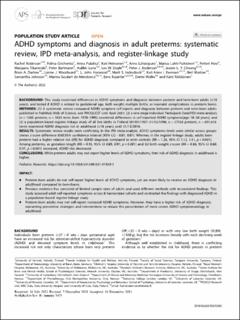| dc.contributor.author | Robinson, Rachel | |
| dc.contributor.author | Girchenko, Polina | |
| dc.contributor.author | Pulakka, Anna | |
| dc.contributor.author | Heinonen, Kati | |
| dc.contributor.author | Lähdepuro, Anna | |
| dc.contributor.author | Lahti-Pulkkinen, Marius | |
| dc.contributor.author | Hovi, Petteri | |
| dc.contributor.author | Tikanmäki, Marjaana | |
| dc.contributor.author | Bartmann, Peter | |
| dc.contributor.author | Lano, Aulikki | |
| dc.contributor.author | Doyle, Lex W. | |
| dc.contributor.author | Anderson, Peter J. | |
| dc.contributor.author | Cheong, Jeanie L. Y. | |
| dc.contributor.author | Darlow, Brian A. | |
| dc.contributor.author | Woodward, Lianne J. | |
| dc.contributor.author | Horwood, L. John | |
| dc.contributor.author | Indredavik, Marit Sæbø | |
| dc.contributor.author | Evensen, Kari Anne Indredavik | |
| dc.contributor.author | Marlow, Neil | |
| dc.contributor.author | Johnson, Samantha | |
| dc.contributor.author | de Mendonca, Marina Goulart | |
| dc.contributor.author | Kajantie, Eero Olavi | |
| dc.contributor.author | Wolke, Dieter | |
| dc.contributor.author | Räikkönen, Katri | |
| dc.date.accessioned | 2023-04-13T11:38:01Z | |
| dc.date.available | 2023-04-13T11:38:01Z | |
| dc.date.created | 2022-04-11T11:08:19Z | |
| dc.date.issued | 2022 | |
| dc.identifier.citation | Pediatric Research. 2022, . | en_US |
| dc.identifier.issn | 0031-3998 | |
| dc.identifier.uri | https://hdl.handle.net/11250/3062888 | |
| dc.description.abstract | Background
This study examined differences in ADHD symptoms and diagnosis between preterm and term-born adults (≥18 years), and tested if ADHD is related to gestational age, birth weight, multiple births, or neonatal complications in preterm borns.
Methods
(1) A systematic review compared ADHD symptom self-reports and diagnosis between preterm and term-born adults published in PubMed, Web of Science, and PROQUEST until April 2021; (2) a one-stage Individual Participant Data(IPD) meta-analysis (n = 1385 preterm, n = 1633 term; born 1978–1995) examined differences in self-reported ADHD symptoms[age 18–36 years]; and (3) a population-based register-linkage study of all live births in Finland (01/01/1987–31/12/1998; n = 37538 preterm, n = 691,616 term) examined ADHD diagnosis risk in adulthood (≥18 years) until 31/12/2016.
Results
Systematic review results were conflicting. In the IPD meta-analysis, ADHD symptoms levels were similar across groups (mean z-score difference 0.00;95% confidence interval [95% CI] −0.07, 0.07). Whereas in the register-linkage study, adults born preterm had a higher relative risk (RR) for ADHD diagnosis compared to term controls (RR = 1.26, 95% CI 1.12, 1.41, p < 0.001). Among preterms, as gestation length (RR = 0.93, 95% CI 0.89, 0.97, p < 0.001) and SD birth weight z-score (RR = 0.88, 95% CI 0.80, 0.97, p < 0.001) increased, ADHD risk decreased.
Conclusions
While preterm adults may not report higher levels of ADHD symptoms, their risk of ADHD diagnosis in adulthood is higher.
Impact
- Preterm-born adults do not self-report higher levels of ADHD symptoms, yet are more likely to receive an ADHD diagnosis in adulthood compared to term-borns.
- Previous evidence has consisted of limited sample sizes of adults and used different methods with inconsistent findings. This study assessed adult self-reported symptoms across 8 harmonized cohorts and contrasted the findings with diagnosed ADHD in a population-based register-linkage study.
- Preterm-born adults may not self-report increased ADHD symptoms. However, they have a higher risk of ADHD diagnosis, warranting preventive strategies and interventions to reduce the presentation of more severe ADHD symptomatology in adulthood. | en_US |
| dc.language.iso | eng | en_US |
| dc.publisher | Nature | en_US |
| dc.rights | Navngivelse 4.0 Internasjonal | * |
| dc.rights.uri | http://creativecommons.org/licenses/by/4.0/deed.no | * |
| dc.subject | Lav fødselsvekt | en_US |
| dc.subject | Low birth weigth | en_US |
| dc.subject | ADHD | en_US |
| dc.subject | ADHD | en_US |
| dc.subject | Preterm fødsel | en_US |
| dc.subject | Preterm birth | en_US |
| dc.title | ADHD symptoms and diagnosis in adult preterms: systematic review, IPD meta-analysis, and register-linkage study | en_US |
| dc.title.alternative | ADHD symptoms and diagnosis in adult preterms: systematic review, IPD meta-analysis, and register-linkage study | en_US |
| dc.type | Peer reviewed | en_US |
| dc.type | Journal article | en_US |
| dc.description.version | publishedVersion | en_US |
| dc.subject.nsi | VDP::Medisinske fag: 700 | en_US |
| dc.subject.nsi | VDP::Midical sciences: 700 | en_US |
| dc.source.pagenumber | 0 | en_US |
| dc.source.journal | Pediatric Research | en_US |
| dc.identifier.doi | 10.1038/s41390-021-01929-1 | |
| dc.identifier.cristin | 2016666 | |
| dc.relation.project | Norges forskningsråd: 283791 | en_US |
| dc.relation.project | EU – Horisont Europa (EC/HEU): Grant 733280 | en_US |
| cristin.ispublished | true | |
| cristin.fulltext | original | |
| cristin.qualitycode | 1 | |

